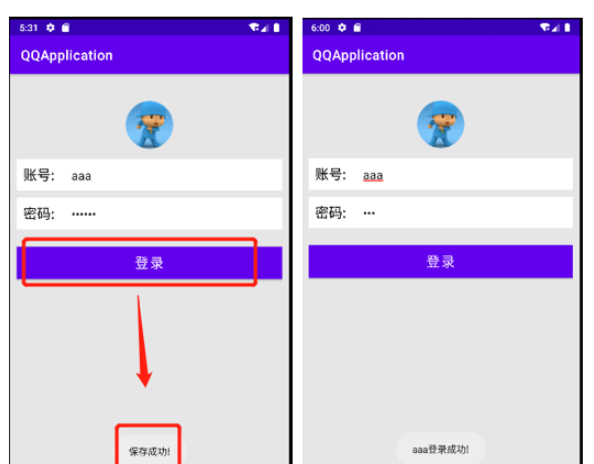这篇文章主要讲解了“android文件存储和SharedPreferences存储的方法”,文中的讲解内容简单清晰,易于学习与理解,下面请大家跟着小编的思路慢慢深入,一起来研究和学习“android文件存储和SharedPreferences存储的方法”吧!



activity_main
<?xml version="1.0" encoding="utf-8"?>
<LinearLayout xmlns:android="http://schemas.android.com/apk/res/android"
xmlns:app="http://schemas.android.com/apk/res-auto"
xmlns:tools="http://schemas.android.com/tools"
android:layout_width="match_parent"
android:layout_height="match_parent"
android:background="#E6E6E6"
android:orientation="vertical"
android:padding="10dp"
tools:context=".MainActivity">
<ImageView
android:layout_width="70dp"
android:layout_height="70dp"
android:layout_centerHorizontal="true"
android:layout_gravity="center_horizontal"
android:layout_marginTop="30dp"
android:src="@drawable/head" />
<LinearLayout
android:layout_width="match_parent"
android:layout_height="wrap_content"
android:layout_marginTop="15dp"
android:background="@android:color/white"
android:orientation="horizontal">
<TextView
android:layout_width="wrap_content"
android:layout_height="wrap_content"
android:padding="10dp"
android:text="账号:"
android:textColor="#000"
android:textSize="20sp" />
<EditText
android:id="@+id/et_account"
android:layout_width="match_parent"
android:layout_height="wrap_content"
android:layout_marginLeft="5dp"
android:background="@null"
android:padding="10dp" />
</LinearLayout>
<LinearLayout
android:layout_width="match_parent"
android:layout_height="wrap_content"
android:layout_marginTop="10dp"
android:background="@android:color/white"
android:orientation="horizontal">
<TextView
android:id="@+id/tv_password"
android:layout_width="wrap_content"
android:layout_height="wrap_content"
android:padding="10dp"
android:text="密码:"
android:textColor="#000"
android:textSize="20sp" />
<EditText
android:id="@+id/et_password"
android:layout_width="match_parent"
android:layout_height="wrap_content"
android:layout_marginLeft="5dp"
android:background="@null"
android:inputType="textPassword"
android:padding="10dp" />
</LinearLayout>
<Button
android:id="@+id/btn_login"
android:layout_width="match_parent"
android:layout_height="wrap_content"
android:layout_marginTop="25dp"
android:background="#3C8DC4"
android:text="登录"
android:textColor="@android:color/white"
android:textSize="20sp" />
</LinearLayout>MainActivity
/**
* 文件存储和SharedPreferences存储实例
*/
public class MainActivity extends AppCompatActivity {
private EditText et_account, et_password; //账号输入框、密码输入框
private Button loginBtn; //登录按钮
@Override
protected void onCreate(Bundle savedInstanceState) {
super.onCreate(savedInstanceState);
setContentView(R.layout.activity_main);
initView();
}
private void initView() {
et_account = findViewById(R.id.et_account);
et_password = findViewById(R.id.et_password);
loginBtn = findViewById(R.id.btn_login);
//点击监听事件
loginBtn.setOnClickListener(new View.OnClickListener() {
@Override
public void onClick(View view) {
switch (view.getId()) {
case R.id.btn_login:
//当点击登录按钮时,获取界面上输入的 QQ 账号和密码
String account = et_account.getText().toString().trim();
String password = et_password.getText().toString();
//检验输入的账号和密码是否为空
if (TextUtils.isEmpty(account)) {
Toast.makeText(getApplicationContext(), "请输入 QQ 账号", Toast.LENGTH_SHORT).show();
return;
}
if (TextUtils.isEmpty(password)) {
Toast.makeText(getApplicationContext(), "请输入密码", Toast.LENGTH_SHORT).show();
return;
}
//文件存储
//saveOfFile(account,password);
//SharedPreferences存储
saveOfSharedPreferences(account,password);
break;
}
}
});
}
//SharedPreferences存储
private void saveOfSharedPreferences(String account, String password) {
//获取 QQ 账号和密码信息
SharedPreferences userInfo=SPSaveQQ.getUserInfo(getApplicationContext());
if (userInfo.getString("username", "") != null&&userInfo.getString("pwd", "") != null) {
String username = userInfo.getString("username", "");//读取账号
String pwd = userInfo.getString("pwd", "");//读取密码
Log.i("user", "读取用户信息");
Log.i("user", "username:" + username + ", pwd:" + pwd);
if (username.equals(account) && pwd.equals(password)) {
Toast.makeText(getApplicationContext(), username+"登录成功!", Toast.LENGTH_SHORT).show();
}else {
Log.i("user", "用户或密码错误!");
//保存用户信息
boolean isSaveSuccess = SPSaveQQ.saveUserInfo(getApplicationContext(), account, password);
if (isSaveSuccess) {
Toast.makeText(getApplicationContext(), "保存成功!", Toast.LENGTH_SHORT).show();
} else {
Toast.makeText(getApplicationContext(), "保存失败!", Toast.LENGTH_SHORT).show();
}
}
}else{
//保存用户信息
boolean isSaveSuccess = SPSaveQQ.saveUserInfo(getApplicationContext(), account, password);
if (isSaveSuccess) {
Toast.makeText(getApplicationContext(), "保存成功!", Toast.LENGTH_SHORT).show();
} else {
Toast.makeText(getApplicationContext(), "保存失败!", Toast.LENGTH_SHORT).show();
}
}
}
//文件存储
private void saveOfFile(String account, String password) {
//获取 QQ 账号和密码信息
Map<String, String> userInfo = FileSaveQQ.getUserInfo(getApplicationContext());
if (userInfo != null) {
//将获取的账号显示到界面上
et_account.setText(userInfo.get("account"));
//将获取的密码显示到界面上
et_password.setText(userInfo.get("password"));
Toast.makeText(getApplicationContext(), userInfo.get("account")+"登录成功!", Toast.LENGTH_SHORT).show();
}else{
//保存用户信息
boolean isSaveSuccess = FileSaveQQ.saveUserInfo(getApplicationContext(), account, password);
if (isSaveSuccess) {
Toast.makeText(getApplicationContext(), "保存成功!", Toast.LENGTH_SHORT).show();
} else {
Toast.makeText(getApplicationContext(), "保存失败!", Toast.LENGTH_SHORT).show();
}
}
}
}FileSaveQQ
/**
* 实现 QQ 账号与密码的文件存取与读取功能
*/
public class FileSaveQQ {
/**
* 保存用户信息
* @param context
* @param account 账号
* @param password 密码
* @return
*/
public static boolean saveUserInfo(Context context, String account, String password) {
//文件的输出流对象
FileOutputStream fos = null;
try {
//获取文件的输出流对象 fos,该文件只能被当前程序读写
fos = context.openFileOutput("user.txt",
Context.MODE_PRIVATE);
//将数据转换为字节码的形式写入 user.txt 文件中
fos.write((account + ":" + password).getBytes());
return true;
} catch (Exception e) {
e.printStackTrace();
return false;
}finally {
try {
if(fos != null){
fos.close();
}
} catch (IOException e) {
e.printStackTrace();
}
}
}
/**
* 从 user.txt 文件中获取存储的用户信息
* @param context
* @return
*/
public static Map<String, String> getUserInfo(Context context) {
String content = "";
//文件的输入流对象
FileInputStream fis = null;
try {
//获取文件的输入流对象 fis
fis = context.openFileInput("user.txt");
//将输入流对象中的数据转换为字节码的形式
byte[] buffer = new byte[fis.available()];
//通过 read()方法读取字节码中的数据
fis.read(buffer);
//将获取的字节码转换为字符串
content = new String(buffer);
Map<String, String> userMap = new HashMap<String, String>();
String[] infos = content.split(":");
//放入账号密码
userMap.put("account", infos[0]);
userMap.put("password", infos[1]);
Log.i("user", "读取用户信息");
Log.i("user", "account:" + infos[0] + ", password:" + infos[1]);
return userMap;
} catch (Exception e) {
e.printStackTrace();
return null;
} finally {
try {
if (fis != null) {
fis.close();
}
} catch (IOException e) {
e.printStackTrace();
}
}
}
}SPSaveQQ
/**
* 实现 QQ 账号与密码SharedPreferences的存取与读取功能
*/
public class SPSaveQQ {
/**
* 保存用户信息
*/
public static boolean saveUserInfo(Context context, String account, String password){
SharedPreferences sharedPreferences = null;
try {
sharedPreferences = context.getSharedPreferences("user", Context.MODE_PRIVATE);
SharedPreferences.Editor editor = sharedPreferences.edit();//获取编辑器
editor.putString("username", account);
editor.putString("pwd", password);
editor.commit();//提交修改
return true;
}catch (Exception e){
e.printStackTrace();
return false;
}finally {
if(sharedPreferences != null){
return true;
}
return false;
}
}
/**
* 读取用户信息
*/
public static SharedPreferences getUserInfo(Context context){
SharedPreferences userInfo = context.getSharedPreferences("user", Context.MODE_PRIVATE);
return userInfo;
}
}感谢各位的阅读,以上就是“android文件存储和SharedPreferences存储的方法”的内容了,经过本文的学习后,相信大家对android文件存储和SharedPreferences存储的方法这一问题有了更深刻的体会,具体使用情况还需要大家实践验证。这里是亿速云,小编将为大家推送更多相关知识点的文章,欢迎关注!
亿速云「云服务器」,即开即用、新一代英特尔至强铂金CPU、三副本存储NVMe SSD云盘,价格低至29元/月。点击查看>>
免责声明:本站发布的内容(图片、视频和文字)以原创、转载和分享为主,文章观点不代表本网站立场,如果涉及侵权请联系站长邮箱:is@yisu.com进行举报,并提供相关证据,一经查实,将立刻删除涉嫌侵权内容。